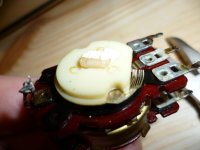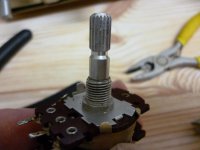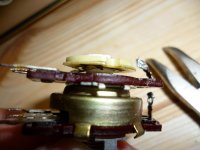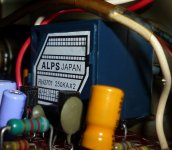'Difficult question.
I bought a 10k dual AX type and gave it away cheaply without testing. Some friends use them in DIY preamps without problems but that's scarcely evidence as their gear isn't always in use. Genuine ALPS "Blue Velvet" pots are finely tuned products with a "feel" that is hard to reproduce cheaply unless very close manufacturing tolerances and fine finishes are used. I doubt that is necessary to keep an older amplifier working and as I can't say there any other faults, the fakes should be OK for a few years hard work at least.
This one looks like a "knock-off" - 360433390650. I know nothing about it but how far can you go wrong?
The fakes I've seen aren't junk but sometimes the price is little different to the original. I saw a couple of threads elsewhere on picking the difference but they read like a lot of generalisations and the OP was none the wiser after a page or so. Not much help!
If the cleaning solution has become ineffective as Mooly warned, disassembling those big old pots is definitely an option and not that difficult. You need some nice narrow-nose pliers and a fine, hard tip screwdriver to use as a wedge to prise the lugs. They come apart easy enough, but only so far because the rear rotor will be peened to the shaft. You still have some access to the front section and you can re-tension the wipers and bend them to a different path but keep the same trailing angle of the contact to the resistive track. I use some solid looking tweezers for this since they need to remain parallel when gripping and pushing. It's tedious first time but an intrepid DIY should relish the opportunity to experiment at least. 🙂
I admit, my first attempt at this when I was quite young was not successful for long but I figured it out with Dad scowling disapproval over my shoulder, as boys do....
I bought a 10k dual AX type and gave it away cheaply without testing. Some friends use them in DIY preamps without problems but that's scarcely evidence as their gear isn't always in use. Genuine ALPS "Blue Velvet" pots are finely tuned products with a "feel" that is hard to reproduce cheaply unless very close manufacturing tolerances and fine finishes are used. I doubt that is necessary to keep an older amplifier working and as I can't say there any other faults, the fakes should be OK for a few years hard work at least.
This one looks like a "knock-off" - 360433390650. I know nothing about it but how far can you go wrong?
The fakes I've seen aren't junk but sometimes the price is little different to the original. I saw a couple of threads elsewhere on picking the difference but they read like a lot of generalisations and the OP was none the wiser after a page or so. Not much help!
If the cleaning solution has become ineffective as Mooly warned, disassembling those big old pots is definitely an option and not that difficult. You need some nice narrow-nose pliers and a fine, hard tip screwdriver to use as a wedge to prise the lugs. They come apart easy enough, but only so far because the rear rotor will be peened to the shaft. You still have some access to the front section and you can re-tension the wipers and bend them to a different path but keep the same trailing angle of the contact to the resistive track. I use some solid looking tweezers for this since they need to remain parallel when gripping and pushing. It's tedious first time but an intrepid DIY should relish the opportunity to experiment at least. 🙂
I admit, my first attempt at this when I was quite young was not successful for long but I figured it out with Dad scowling disapproval over my shoulder, as boys do....
Thanks Ian I went ahead and ordered that pot, when it finally arrived I had to adapt all the pins just to get it to fit, but that's ok I expected that. I ohms tested both channels on the pot before putting it in, fully open, one side read 4.5 the other 2.5 odd? It also has a step feel to the control, not a smooth movement like the original. It did seem to sort of work but now I have to turn it up twice as far to get the same volume.
I did try taking the original pot apart, but this is as far as I got the thing will not disassemble any more than this. The picture of the mettle shaft shows a little washer that is not a split locking washer that must have been put on first, and then the rest of the assembly slid into place until finally glued at the back.
Attachments
Disassembling the old one was definitely worth a shot.
As to your new one... well if the resistive track is linear rather than log then that will alter the "level vs rotation" feel of the pot but ultimately will reach the same level when turned on full. Not quite sure what you mean as to the other thing, you mean it has a mechanical "detent" feel to it as it is turned.
As to your new one... well if the resistive track is linear rather than log then that will alter the "level vs rotation" feel of the pot but ultimately will reach the same level when turned on full. Not quite sure what you mean as to the other thing, you mean it has a mechanical "detent" feel to it as it is turned.
So it could possibly be a linear pot the from what I described. This is the question I asked the seller before purchase..
"Hi is this item logarithmic? and does it have loudness? Thank you."
And this was the answer.
"Dear friend: I know it is Stereo only.Best regards and thanks."
So what can you do?
Should I find a log pot now?
"Hi is this item logarithmic? and does it have loudness? Thank you."
And this was the answer.
"Dear friend: I know it is Stereo only.Best regards and thanks."
So what can you do?
Should I find a log pot now?
Being linear is no real disadvantage imo. In fact linear pots are often better matched between the two gangs.
You can fiddle a linear to be more like a log one by adding a resistor. Scroll down to where it says "changing the law of a pot"
Potentiometers (Beginners' Guide to Pots)
If you wanted a log pot then something like this should be ideal (check it would physically fit first). There is no loudness tapping though.
PC2G16ECO220KB - OMEG - POT, DUAL GANG, LOG, 220K | CPC
You can fiddle a linear to be more like a log one by adding a resistor. Scroll down to where it says "changing the law of a pot"
Potentiometers (Beginners' Guide to Pots)
If you wanted a log pot then something like this should be ideal (check it would physically fit first). There is no loudness tapping though.
PC2G16ECO220KB - OMEG - POT, DUAL GANG, LOG, 220K | CPC
Having looked up the details of ALPS pots a few times, when you read the label, there is a part number which follows the series part prefix RK27112..... Together with the specific part reference, that should be useful to search with Google for a datasheet saying precisely what it is.
Also, there is a descriptive code like 10KAX2, which means a dual 10K log pot.
In this series, B does mean linear, so 10KBX2 would be a 10K linear pot. That isn't the case for all Japanese pots though.
Most amplifiers only had "clicker plates" for the volume control setting. A single detent was usual at the centre travel of the balance, treble and bass pots. Consider that when you are trying to decide what you have there.
Copy this Ebay ref. number into your browser or simply Google it and check the PDF datasheet links posted on the Familygate Ebay site it refers to: 260964426367. This covers their stock types so others may need a bit more searching for your type by either reference. It should help to find the spec. of what you have though I can't imagine why a tapped audio pot. would be needed for anything other than a volume control.
Also, there is a descriptive code like 10KAX2, which means a dual 10K log pot.
In this series, B does mean linear, so 10KBX2 would be a 10K linear pot. That isn't the case for all Japanese pots though.
Most amplifiers only had "clicker plates" for the volume control setting. A single detent was usual at the centre travel of the balance, treble and bass pots. Consider that when you are trying to decide what you have there.
Copy this Ebay ref. number into your browser or simply Google it and check the PDF datasheet links posted on the Familygate Ebay site it refers to: 260964426367. This covers their stock types so others may need a bit more searching for your type by either reference. It should help to find the spec. of what you have though I can't imagine why a tapped audio pot. would be needed for anything other than a volume control.
Last edited:
Yes in the U.K Bx2 means logarithmic but in America it means linear. God knows what it means in China.
But I do appreciate everyone’s help. Thank you
But I do appreciate everyone’s help. Thank you
I'm not sure what you have there tbh. I can't find anything in the ALPS catalogue that has that number. They list one that has a 31 "detent", your clicky action but its not 270k. In fact they don't seem to list any over 100k these days (unless I'm looking in the wrong place).
RK271 Series - Basic information
RK271 Series - Basic information
I had a good look too it is a made up number. Also with the volume at it's lowest setting I can still hear some sound, you don't think I wired this up wrong do you? after all if I did it would not work at all would it?
Wouldn't have thought you wired it wrong. Middle pin is the output on them all, so as long as that is OK and wired the same as the orginal then the only other effect of getting the outer two pins mixed is that the control would work back to front.
Are we saying its a fake part then ?
The one I linked to (from CPC) is a good quality part, probably much better than the original fitment tbh.
Are we saying its a fake part then ?
The one I linked to (from CPC) is a good quality part, probably much better than the original fitment tbh.
YES it's fake but we knew this before hand, did we not? £5 from china, but i did think it would be a close copy of the original or at least a fair approximation, i don't think Alps even make a 250k pot with a knurled shaft.
Thanks Mooly but that pot in your link, the shaft is too long it's not knurled the volume knob will not go on and it has no loudness.
I know it has no loudness... getting one that has could be a big challenge. The shaft length isn't a problem and can be cut to any length. Just secure the shaft, not the pot in a vice. Actually those particular polycarbonate shafts cut really easily with a pair of cutters too although you don't get a clean edge doing that.
Uh-huh. Well as you find, RH27... isn't an ALPS series that shows on the web. Mouser have this ALPS part number coding document in their catalogue for genuine parts but I don't know the scope of it, i.e. how far back it goes in reference to earlier products or deleted codes.
I suggest you simply grab your multimeter and measure the resistance from wiper to ground as you rotate it and draw yourself a little graph of rotation angle or even clicks per ohm. Note that there will be the balance control in parallel with this, putting 125k across each volume pot. at mid setting. It seems you can isolate the volume pot at points 11 and 12, according to the schematic, to test it in circuit. When there are no other pure resistances in parallel with the pot, only a linear pot. or a balance pot. will show half DC resistance at its midpoint. Log pots follow some form of logarithmic progression of resistance to approximate our hearing sensitivity. How this is interpreted and achieved in production by different manufacturers and for different applications, such as when a loudness tap is added, seems to vary widely so don't expect precise log. character - check the graph in the link and an earlier post.
As Mooly suggested earlier, you can achieve a lot to add log. character to a linear resistance but with the complexity of the loudness tap, I suspect that will be nigh impossible. Here's the article for interest and a lot more interesting info: Potentiometers (Beginners' Guide to Pots)
As you have fitted it after considerable effort and it works in some fashion, any sound at minimum is a worry, since the wiper should be shorted to the minimum volume end of the resistance i.e. grounded to signal ground (as at the input sockets) at full CCW position. There is no way to get sound past that since the tap is connected directly and is the only connection to the amplifier inputs. It seems unlikely that the pot is wired incorrectly as the connection pins, apart from the offset tapping pin, should be so obviously the same as the original pot.
Is this minimum volume end really grounded and does the wiper come to the same zero resistance at min. volume? Are you otherwise happy with it despite the change in setting position (no excess noise, dull sound etc) ? I'm asking this because if the pins were bent in order to fit the pot, there may be a broken internal connection but not likely the same in both channels. That may give clues to the remaining problems. 🙁
I suggest you simply grab your multimeter and measure the resistance from wiper to ground as you rotate it and draw yourself a little graph of rotation angle or even clicks per ohm. Note that there will be the balance control in parallel with this, putting 125k across each volume pot. at mid setting. It seems you can isolate the volume pot at points 11 and 12, according to the schematic, to test it in circuit. When there are no other pure resistances in parallel with the pot, only a linear pot. or a balance pot. will show half DC resistance at its midpoint. Log pots follow some form of logarithmic progression of resistance to approximate our hearing sensitivity. How this is interpreted and achieved in production by different manufacturers and for different applications, such as when a loudness tap is added, seems to vary widely so don't expect precise log. character - check the graph in the link and an earlier post.
As Mooly suggested earlier, you can achieve a lot to add log. character to a linear resistance but with the complexity of the loudness tap, I suspect that will be nigh impossible. Here's the article for interest and a lot more interesting info: Potentiometers (Beginners' Guide to Pots)
As you have fitted it after considerable effort and it works in some fashion, any sound at minimum is a worry, since the wiper should be shorted to the minimum volume end of the resistance i.e. grounded to signal ground (as at the input sockets) at full CCW position. There is no way to get sound past that since the tap is connected directly and is the only connection to the amplifier inputs. It seems unlikely that the pot is wired incorrectly as the connection pins, apart from the offset tapping pin, should be so obviously the same as the original pot.
Is this minimum volume end really grounded and does the wiper come to the same zero resistance at min. volume? Are you otherwise happy with it despite the change in setting position (no excess noise, dull sound etc) ? I'm asking this because if the pins were bent in order to fit the pot, there may be a broken internal connection but not likely the same in both channels. That may give clues to the remaining problems. 🙁
Hello Ian, The pins on the pot were only slightly bent, the rest was done with wire wrap it was then bolted on the front facia and then finally soldered to the board. Like I say I do get some sound when the volume is supposed to be all the way off, the sound is just as clear as the original so no complaints there.
But there is another problem when I play a 250hz signal from my blu ray player to this amp I get a sort of resonating sound and crackle through this amp that I do not get through my arcam. I was getting this before and was hoping the new pot would fix it but it has not.
Is the blu ray overdriving the input sensitivity of this amp.
But there is another problem when I play a 250hz signal from my blu ray player to this amp I get a sort of resonating sound and crackle through this amp that I do not get through my arcam. I was getting this before and was hoping the new pot would fix it but it has not.
Is the blu ray overdriving the input sensitivity of this amp.
- Status
- Not open for further replies.
- Home
- Amplifiers
- Solid State
- Can anyone help with JVC JAS22




